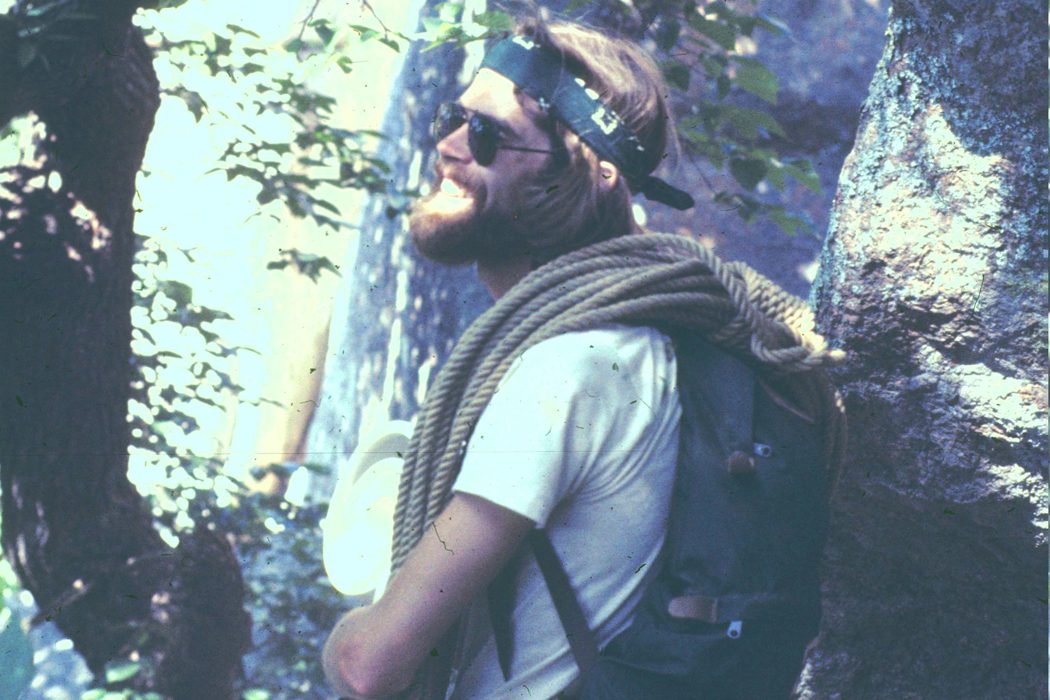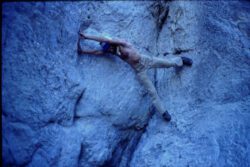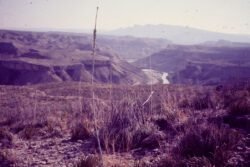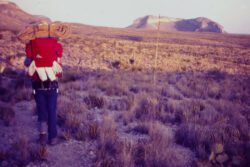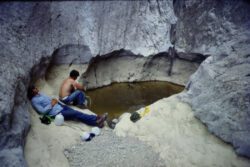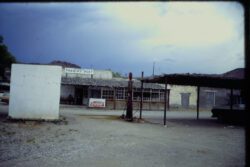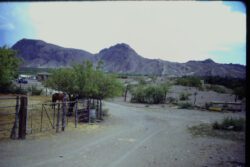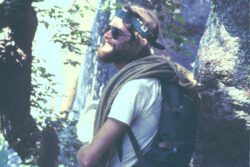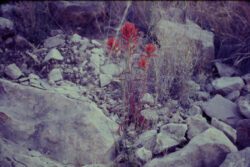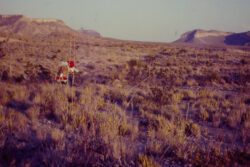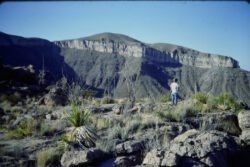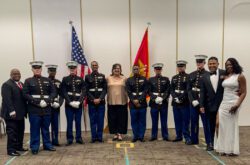By Robert "Bob" Bussey
For this month and next month, we will present an article about the Mesa de Anguila, a relatively untraveled part of Big Bend National Park in Texas. Bob Bussey, who usually writes articles about CenLa poets for 318Central, is also an avid traveler.
Back a few years ago, he and two friends went on a multi-day backpacking trip across the Mesa. The two articles will recount that trip.
Bob Bussey lives in CenLa. Before moving here, he lived in the Austin, Texas area where he was deeply involved in wilderness activities. He worked for the Austin Natural Science Center where he led backpacking, canoeing, kayaking, rock climbing, and spelunking trips. He also worked for REC sports, a division of the University of Texas, where he led similar activities throughout Mexico and the United States. He also was a leader in an organization called Outback Expeditions. Later he became a bicycle
tour leader for American Youth Hostels, leading six week bicycle camping trips, completely self-contained, throughout the United States. He later obtained his master’s degree in Outdoor Education from the University of Northern Illinois. He now lives in CenLa where he is still active in outdoor activities. If you would like to learn more about the Mesa de Anguila, he can be reached at Rlbussey450@icloud.com.
…
In an Indian version of the creation of the world, the Great Creator had a chunk of matter left over after he made the oceans, the sky, the living things, and the land. The Creator took this worthless hunk of matter and threw it down on the earth with no purpose in mind, thus creating Big Bend National Park. The last bit of heavenly matter to hit the earth must have landed in the southwest corner of the park, creating Mesa de Anguila. It is the most desolate of desolate places within the park. There are no roads leading to it, no marked trails on it, and little water once you are on its tabletop. Most of the spiny plants that grow there should be growing in hell. Vultures, lizards, and snakes are the only animals that are readily apparent. Temperatures in the summer soar to the 100 degrees plus range; in the winter they plunge to well below freezing during the night. Spring and fall are the only two favorable seasons in which to venture upon the mesa. Even then the temperatures can vary like the disposition of a mule. The land that has felt the Comanche Indians, Chico Cano, and J.C. Langford, beckons its challenge to the wilderness traveler. In the early days it was inaccessible; today much of the country is still unapproachable for everyone except backpackers.
Three of us — Derrick Stanford, David Kinney, and myself — planned to hike from the west side to the east side of the Mesa de Anguila during the month of April. (A 40-mile trek.) Due to the season of the trip, spring, we would have to carry clothing for cool and hot weather. Spring temperatures can range from the 30s to the l00s. But our main concern was the water situation on top of the mesa. Most of the water that does fall on the mesa during a rain quickly flows into gullies, which become deep side canyons of Santa Elana Canyon, and rush down into the Rio Grande River to the south of the mesa. The little water that remains on the mesa becomes trapped in”tinajas,” or water holes. These tinajas are the only water sources on top of the mesa for both man and beast. With the lack of rain during the winter months, most of the tinajas are bone dry; those that do have water are often stale or contaminated. The GSU topo map for the Mesa de Anguila indicates two major tinajas: Tinaja Lujan and Tinaja Blanca. Both of those tinajas were dry when we crossed the mesa. Instead of relying on the topo map for water, we relied on our knowledge of where to look for water in the desert-mesa environment. To make sure we did not contract any disease caused by bacteria, we used a water filtration system plus water purification tablets on all the water we took from the tinajas.
A month before the hike, we started to condition our bodies, feet, backs, and minds. We were in decent shape due to a jogging schedule we kept. But backpacking with 50-to-70-pound packs (24 pounds being the three gallons of water we each carried) in desert heat takes a special kind of body and mental determination. To condition ourselves, we started to carry progressively heavier packs, twice a week, for ten-mile hikes. The week before the trip, we carried full packs on our training hikes. This advance preparation helped us overcome the weekend backpacker’s syndrome: sore muscles the first two days out. Our bodies, minds, feet, and boots were ready to take on the Mesa de Anguila, or at least we thought they were ready. The actual hike into the mesa began at Lajitas, a small villa to the west of Big Bend. The distance from Lajitas to the top of the mesa is about three miles, with an elevation increase of about 1500 feet. You climb the 1500 feet in the last half-mile. After climbing up the western slope of the mesa for some time, we realized that our water supply would not carry us the distance we had hoped. By the time we had reached the top we had each gone through a gallon of water. The weather, always a tricky factor in southwest Texas, had decided to heat up to 95 degrees by noon time. Our bodies, which had been conditioned to carry heavy loads in a cooler climate, were struggling to keep cool. Sweat was pouring out of us. By the end of the first day, we had each gone through 2 gallons or more of water. The three gallons of water that we each carried would not see us all the way across the mesa, a possibility that we had foreseen. The hunt for wet tinajas was on.
Even though we were not acclimated to the heat, we were still able to cope with it. Knowing that the sun in southwest Texas can be blistering, we brought along light-colored clothing and caps. Caps or hats are extremely important in the desert sun. They keep the sun’s rays directly off your head, thus keeping your brain much cooler. The light-colored clothing that we wore reflected a great deal of the sun’s rays. The perspiration absorbed into our clothing acted as another cooling system as it quickly evaporated into the dry desert air. Besides water we also dealt with two other basic physiological processes: energy and salt intake. Neglecting any of these three basics causes undue stress on one’s body in a hot desert environment. Salt intake was dealt with by chewing on beef jerky as we walked. I have always preferred beef jerky over salt tablets. The taste is far superior, and you get to chew on something instead of just swallowing a pill. Our energy output was at high levels due to the heat, the weight of the packs, the terrain we were crossing, and the amount of cooling our bodies were doing. To keep our caloric intake high, we consumed hard candy when we weren’t munching on jerky. Many people think that you only need extra energy when dealing with wintry conditions. However, heat can sap you of your energy just as fast and have just as fatal a result as the cold. Using the four defenses — light colored clothing, adequate water, salt and energy intake, plus taking our time on the first day out — made it possible for us to keep moving across the mesa. Because we had taken care of our basic requirements, we didn’t experience many problems except: drenched clothes, salty beards, soggy socks, hot feet, grimy skin, and short tempers. The desert sun, its accompanying heat, and the desert terrain will soon teach any macho backpacker respect.
The gung-ho, plow-ahead type of backpacker soon ends up on the side of the trail wondering what he or she could be doing wrong. The heat of the desert and the cold of the mountains demand careful preparation, respect for the needs of the human body, and a good working knowledge of the effects of the environment on the individual.
After the climb up the side of the mesa we finally stood at its tabletop. At this point, the pains of the upward hike seemed to melt away. Vistas opened up to us that we had never seen before. To the east we could see a mountain which we later named Brokenback Mountain — rising out of the mesa floor. To the south we saw Santa Elana Canyon, through which the Rio Grande flows. Farther to the south we could see the Sierra Ponce, which is in the Mexican state of Chihuahua. And, directly in front of us, there was a myriad of burro trails leading off in every direction, which captivated our attention.
The trails that exist on the Mesa de Anguila (if you want to call them trails) were formed, when the settlers in the Big Bend area were using the mesa as a big open-air wax making factory. The settlers took their burros onto the mesa to find candelilla plants, a plant that can be rendered to produce a gray looking wax. This was big business in the early twentieth century for that area of the country. The refined wax was used in the manufacturing of phonograph records, waterproofing munitions during WW I, and even in the insulation of electrical appliances.
The natives of the area used a solution of the plant in the treatment of venereal disease. Its scientific name, Euphoria antisyphilitica, reflects this medical use. Because of this mesa industry, burro trails crisscross each other everywhere you go. We often walked on three different burro trails that ran parallel to one another. Picking the main trail (there is a trail indicated on the GSU topo map) is next to impossible due to the burro trails. The method that worked best for us was to look at our topo map, find the potential tinaja spots, locate Brokenback Mountain on the map, and aim our walking at these objectives. Tinaja Blanca and Tinaja Lujan were on the way to Brokenback and also near other potential tinaja spots, so we also pointed ourselves towards them.
…
Please stay tuned for the October article on the Mesa de Anguila that will conclude the backpacking trip. The Mesa is a hard to reach, hard to travel spot, that is not too far from CenLa. Adventurous spirits might want to give it a try. Planning, preparation, and a determined spirit are key to crossing its difficult terrain and environment.






